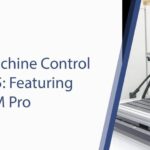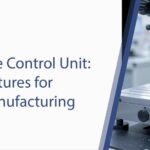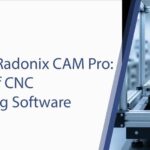In the intricate world of Computer Numerical Control (CNC) machining, precision, speed, and reliability are paramount.
At the heart of every automated milling machine, lathe, router, or plasma cutter lies its most critical component: the control system.
This sophisticated “brain” is responsible for interpreting design code and translating it into precise, repeatable mechanical motion.
Understanding the different types of CNC control systems is not just an academic exercise; it’s a crucial step for any business looking to optimize its manufacturing processes, enhance efficiency, and ultimately, bolster its bottom line.
As a leader in the design and development of advanced CNC solutions, Radonix is deeply committed to empowering manufacturers with the knowledge they need to make informed decisions.
This comprehensive guide will explore the various types of control systems available today, delving into their operational principles, core components, and ideal applications.
We will navigate the fundamental concepts of feedback, compare distinct controller architectures, and illuminate the path toward selecting the perfect control system for your specific needs.
The Fundamental Divide: The Role of Feedback in CNC Control
Before we can categorize CNC control systems, we must first grasp the single most important concept that differentiates them: feedback. A feedback loop is a mechanism by which a system’s output is measured and then fed back to the input to influence and correct its own operation.
In the context of a CNC machine, this means checking if the cutting tool or machine bed has actually moved to the position it was commanded to.
This single principle creates the primary classification of control systems: open-loop and closed-loop.
1. Open-Loop Control Systems: Simplicity and Cost-Effectiveness
An open-loop control system is the most straightforward type of CNC control. It operates on a simple, one-way street of command.
The controller sends a set of instructions to the motor, and it assumes that the motor will execute these instructions perfectly without any verification.
How It Works
The process is direct:
- The CNC controller reads a line of G-code (the programming language of CNC machines).
- It translates this code into a series of electrical pulses.
- These pulses are sent to the drive, which then energizes the motor to move a specific distance.
The system does not receive any information back from the motor or the machine’s moving parts. It “hopes” for the best, relying on the mechanical integrity and predictable performance of its components.
Core Components
The hallmark of an open-loop system is the use of stepper motors. Stepper motors are unique in that they rotate in discrete, fixed increments, or “steps.” The controller can command the motor to move a precise number of steps, and as long as the motor is not overwhelmed by the load, it will move to the desired position.
Advantages of Open-Loop Systems
- Cost-Effectiveness: The absence of expensive feedback devices like encoders makes open-loop systems significantly cheaper to implement.
- Simplicity: With fewer components and simpler electronics, these systems are easier to design, install, and maintain.
- Reliability in Low-Load Applications: When the motor’s torque is well above the required load and external forces are minimal, open-loop systems can be quite reliable.
Disadvantages and Limitations
- Lack of Error Correction: This is the primary drawback. If the motor encounters unexpected resistance (e.g., a hard spot in the material, a sticky bearing) and misses a step, the controller has no way of knowing. This error will persist and compound throughout the rest of the machining process, potentially ruining the workpiece.
- Lower Speed and Torque: To ensure no steps are missed, stepper motors are often run at lower speeds and torques than their full potential.
- Resonance Issues: Stepper motors can experience resonance at certain speeds, leading to vibration and loss of torque, which can affect the surface finish and accuracy of the part.
Ideal Applications
Open-loop systems are best suited for applications where the load is predictable and constant, and where absolute, mission-critical precision is not the primary concern. This includes many:
- Hobbyist and educational CNC machines
- 3D printers
- Laser engravers and cutters
- CNC routers for light-duty woodworking and sign making
2. Closed-Loop Control Systems: The Gold Standard for Precision and Reliability
A closed-loop control system is a two-way communication highway. It doesn’t just send commands; it actively monitors the machine’s performance and makes real-time adjustments to ensure perfect execution.
How It Works
The feedback loop is the key:
- The CNC controller sends a command to the motor, just like in an open-loop system.
- A feedback device, typically an encoder, is attached to the motor or the machine’s leadscrew. This device continuously tracks the exact position and velocity of the moving component.
- This feedback data is sent back to the controller in real-time.
- The controller compares the actual position with the commanded position. If there is any discrepancy (an error), the controller instantly adjusts the signal to the motor to correct the position.
This constant cycle of command, measure, compare, and correct happens thousands of times per second, ensuring that the machine follows the intended path with extraordinary accuracy.
Core Components
Closed-loop systems utilize servo motors and encoders.
- Servo Motors: Unlike stepper motors, servo motors are designed for high-speed, high-torque operation and can run smoothly across their entire speed range. They are built to respond to the corrective signals from the controller.
- Encoders: These are sophisticated sensors that translate motion into an electrical signal. Rotary encoders, the most common type, provide data on the rotational position of the motor shaft, which the controller uses to calculate the linear position of the machine axis.
Advantages of Closed-Loop Systems
- Exceptional Accuracy and Precision: The ability to correct errors in real-time allows for much tighter tolerances and more complex machining operations.
- Higher Speed and Performance: Because the system can correct for any deviations, servo motors can be run at their maximum speed and torque, leading to faster cycle times.
- Reliability: The system can overcome unexpected loads and disturbances, making it far more reliable for demanding industrial applications.
- Error Detection: If the error between the commanded and actual position becomes too large (e.g., due to a crash), the controller can halt the machine to prevent damage.
Disadvantages and Limitations
- Higher Cost: Servo motors, encoders, and the more complex controller and drives are significantly more expensive than their open-loop counterparts.
- Complexity: The system is more complex to set up, and the servo motors often require “tuning” to optimize their performance for a specific machine’s mechanics.
Ideal Applications
Closed-loop control is the standard for virtually all industrial-grade manufacturing where precision and reliability are non-negotiable:
- Aerospace and defense component manufacturing
- Medical device and implant production
- Automotive industry (engine parts, molds)
- High-production metalworking and fabrication
3. Semi-Closed-Loop Systems: A Strategic Compromise
As the name suggests, a semi-closed-loop system offers a middle ground.
In this configuration, the encoder is placed on the motor shaft but not directly on the moving part of the machine (like the table or the spindle).
It confirms that the motor itself has rotated correctly, but it doesn’t account for any mechanical inaccuracies in the components that transfer the motion, such as backlash in a leadscrew or stretching in a belt.
While less precise than a full closed-loop system, it’s a significant improvement over an open-loop system as it ensures the motor itself is not losing its position.
The Controller Architecture: PC-Based vs. Dedicated Hardware
Beyond the feedback loop, another critical distinction lies in the architecture of the controller itself. This is where Radonix’s innovation truly shines.
Dedicated CNC Controllers
For decades, the industry was dominated by dedicated controllers from giants like Fanuc, Siemens, and Heidenhain. These are proprietary, “black-box” systems where the hardware and software are a single, integrated unit.
They are known for their robustness and reliability but come with significant drawbacks:
- High Cost: They represent a major capital investment.
- Rigidity: They offer limited flexibility. Customization is difficult and expensive, if not impossible.
- Proprietary Nature: Users are locked into a single vendor for support, upgrades, and repairs.
PC-Based CNC Controllers: The Modern, Flexible Approach
PC-based control leverages the power, flexibility, and cost-effectiveness of modern personal computers. A specialized motion control card and software are installed in a standard PC, turning it into a powerful, fully-featured CNC controller.
This is the very foundation of Radonix’s philosophy. We believe that manufacturers deserve a control system that is not only powerful but also adaptable to their unique and evolving needs.
The Radonix Advantage: Intelligent, PC-Based Control
Radonix has pioneered the development of high-performance, PC-based CNC control systems that offer a superior alternative to traditional dedicated hardware. Our approach provides a wealth of advantages that directly address the needs of modern manufacturing.
- Unmatched Flexibility: Our controllers, like the versatile PC Smart and PC-Pro series, are designed to work seamlessly with both stepper motors for cost-effective open-loop setups and advanced servo motors for high-precision closed-loop applications. This gives you the power to choose the right level of control for your budget and application.
- Open Architecture and Customization: We empower our users. Our systems are built with an open architecture that allows for extensive customization. This means you can tailor the interface, integrate specialized functions, and adapt the controller to highly specific tasks—a level of freedom impossible with dedicated systems.
- Advanced Connectivity and Industry 4.0 Readiness: Built on a PC platform, our controllers are inherently networkable. With upcoming cloud-based functionality, Radonix controllers enable remote monitoring, real-time data analytics, and seamless integration into a smart factory (Industry 4.0) ecosystem.
- Superior Processing Power: By leveraging the ever-advancing power of PC processors, Radonix controllers can handle extremely complex toolpaths, advanced look-ahead algorithms for smoother motion, and sophisticated calculations for multi-axis kinematics without breaking a sweat.
- Application-Specific Solutions: We understand that one size does not fit all. That’s why we develop specialized solutions like our Torch Height Controller (THC) for plasma cutting, which automatically maintains the optimal torch distance from the material, ensuring perfect cuts and extending consumable life.
- Multi-Axis Capability: From the 3-axis control required for standard milling machines to the complex 6-axis control needed for advanced robotics and fabrication, Radonix offers a scalable solution that can grow with your business.
How to Choose the Right Control System for Your CNC Machine
Selecting the right control system is a strategic decision. Consider the following factors:
- Application: What will you be making? Machining intricate aerospace components requires closed-loop precision, while engraving wooden signs may be perfectly served by an open-loop system.
- Accuracy and Tolerance Requirements: What level of precision do your parts demand? This is often the single most important factor in the open-loop vs. closed-loop debate.
- Budget: While a closed-loop system is more capable, its higher cost must be justifiable. A PC-based system from Radonix offers the flexibility to start with a more affordable configuration and upgrade later.
- Materials: Softer materials like wood and plastic exert less force on the cutting tool, making open-loop systems more viable. Hardened steels and exotic alloys demand the power and rigidity of a closed-loop system.
- Desire for Flexibility and Future-Proofing: Do you anticipate your needs changing? A PC-based controller provides a clear upgrade path and the ability to adapt to new challenges, protecting your investment for the long term.
Conclusion: The Future of Control is Open, Intelligent, and Adaptable
The world of CNC control systems offers a spectrum of solutions, from simple open-loop systems to highly sophisticated, closed-loop industrial powerhouses. The choice between them hinges on a careful balance of application, precision, and budget.
However, the evolution of controller architecture from rigid, dedicated hardware to flexible, powerful PC-based systems has been a game-changer. It has democratized high-performance control, putting the power of customization and advanced functionality into the hands of more manufacturers than ever before.
At Radonix, we are proud to be at the forefront of this evolution. By combining the robust principles of motion control with the flexibility and power of PC-based technology, we provide solutions that are not just controllers, but catalysts for innovation.
We invite you to explore our range of intelligent CNC control systems and discover how Radonix can become the brain behind your manufacturing success.
Ready to elevate your CNC operations? Contact the experts at Radonix today to discuss your control system needs and find the perfect solution to drive your productivity and precision to new heights.
Contact Us:
- E-Mail: info@radonix.com
- Phone: +90 (553) 920 5500








